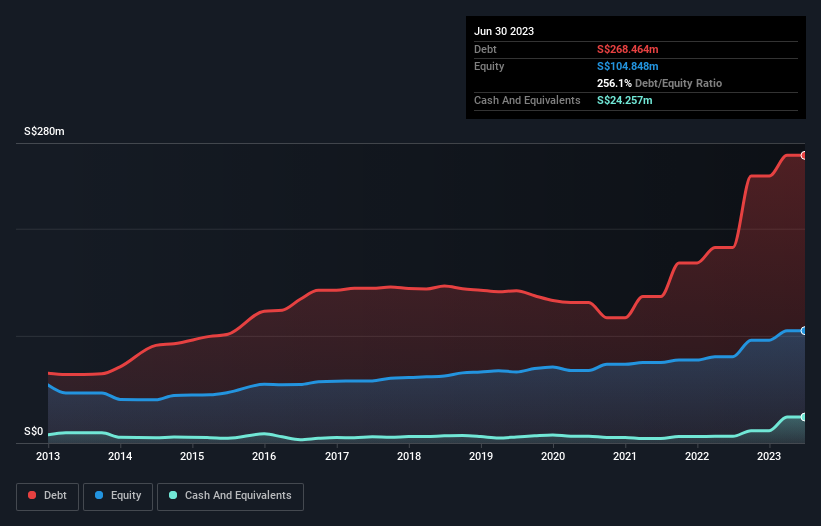Some say volatility, rather than debt, is the best way to think about risk as an investor, but Warren Buffett famously said that 'Volatility is far from synonymous with risk.' When we think about how risky a company is, we always like to look at its use of debt, since debt overload can lead to ruin. As with many other companies Hafary Holdings Limited (SGX:5VS) makes use of debt. But is this debt a concern to shareholders?
When Is Debt Dangerous?
Generally speaking, debt only becomes a real problem when a company can't easily pay it off, either by raising capital or with its own cash flow. If things get really bad, the lenders can take control of the business. However, a more usual (but still expensive) situation is where a company must dilute shareholders at a cheap share price simply to get debt under control. Of course, plenty of companies use debt to fund growth, without any negative consequences. When we think about a company's use of debt, we first look at cash and debt together.
View our latest analysis for Hafary Holdings
What Is Hafary Holdings's Debt?
You can click the graphic below for the historical numbers, but it shows that as of June 2023 Hafary Holdings had S$268.5m of debt, an increase on S$182.6m, over one year. However, it also had S$24.3m in cash, and so its net debt is S$244.2m.

How Healthy Is Hafary Holdings' Balance Sheet?
The latest balance sheet data shows that Hafary Holdings had liabilities of S$147.1m due within a year, and liabilities of S$191.0m falling due after that. Offsetting this, it had S$24.3m in cash and S$55.4m in receivables that were due within 12 months. So it has liabilities totalling S$258.4m more than its cash and near-term receivables, combined.
The deficiency here weighs heavily on the S$133.5m company itself, as if a child were struggling under the weight of an enormous back-pack full of books, his sports gear, and a trumpet. So we definitely think shareholders need to watch this one closely. At the end of the day, Hafary Holdings would probably need a major re-capitalization if its creditors were to demand repayment.
In order to size up a company's debt relative to its earnings, we calculate its net debt divided by its earnings before interest, tax, depreciation, and amortization (EBITDA) and its earnings before interest and tax (EBIT) divided by its interest expense (its interest cover). This way, we consider both the absolute quantum of the debt, as well as the interest rates paid on it.
Hafary Holdings's debt is 4.4 times its EBITDA, and its EBIT cover its interest expense 6.6 times over. This suggests that while the debt levels are significant, we'd stop short of calling them problematic. Notably, Hafary Holdings's EBIT launched higher than Elon Musk, gaining a whopping 123% on last year. There's no doubt that we learn most about debt from the balance sheet. But you can't view debt in total isolation; since Hafary Holdings will need earnings to service that debt. So if you're keen to discover more about its earnings, it might be worth checking out this graph of its long term earnings trend.
Finally, while the tax-man may adore accounting profits, lenders only accept cold hard cash. So the logical step is to look at the proportion of that EBIT that is matched by actual free cash flow. Looking at the most recent three years, Hafary Holdings recorded free cash flow of 38% of its EBIT, which is weaker than we'd expect. That's not great, when it comes to paying down debt.
Our View
Mulling over Hafary Holdings's attempt at staying on top of its total liabilities, we're certainly not enthusiastic. But on the bright side, its EBIT growth rate is a good sign, and makes us more optimistic. Looking at the balance sheet and taking into account all these factors, we do believe that debt is making Hafary Holdings stock a bit risky. That's not necessarily a bad thing, but we'd generally feel more comfortable with less leverage. The balance sheet is clearly the area to focus on when you are analysing debt. However, not all investment risk resides within the balance sheet - far from it. For example, we've discovered 3 warning signs for Hafary Holdings (2 are a bit concerning!) that you should be aware of before investing here.
When all is said and done, sometimes its easier to focus on companies that don't even need debt. Readers can access a list of growth stocks with zero net debt 100% free, right now.
Valuation is complex, but we're here to simplify it.
Discover if Hafary Holdings might be undervalued or overvalued with our detailed analysis, featuring fair value estimates, potential risks, dividends, insider trades, and its financial condition.
Access Free AnalysisHave feedback on this article? Concerned about the content? Get in touch with us directly. Alternatively, email editorial-team (at) simplywallst.com.
This article by Simply Wall St is general in nature. We provide commentary based on historical data and analyst forecasts only using an unbiased methodology and our articles are not intended to be financial advice. It does not constitute a recommendation to buy or sell any stock, and does not take account of your objectives, or your financial situation. We aim to bring you long-term focused analysis driven by fundamental data. Note that our analysis may not factor in the latest price-sensitive company announcements or qualitative material. Simply Wall St has no position in any stocks mentioned.
About SGX:5VS
Hafary Holdings
An investment holding company, engages in import, export, dealing, distribution, wholesale, and trading in building materials.
Established dividend payer and good value.
Market Insights
Community Narratives



